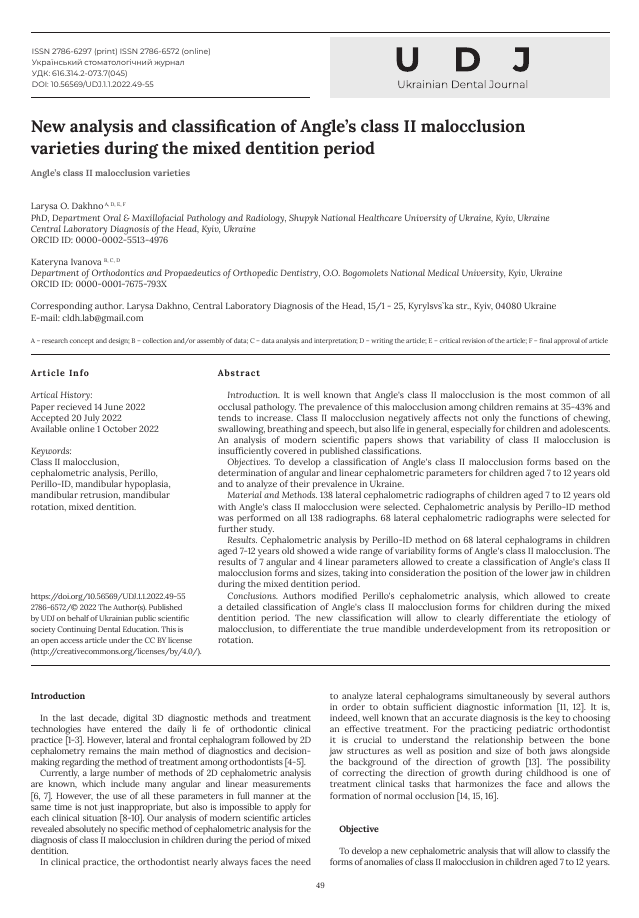New analysis and classiŢcation of Angle’s class II malocclusion varieties during the mixed dentition period
varieties during the mAngle’s cl
DOI:
https://doi.org/10.56569/UDJ.1.1.2022.49-55Keywords:
Class II malocclusion, cephalometric analysis, Perillo, Perillo-ID, mandibular hypoplasia, mandibular retrusion, mandibular rotation, mixed dentitionAbstract
Introduction: It is well known that Angle's class II malocclusion is the most common of all occlusal pathology. The prevalence of this malocclusion among children remains at 35-43% and tends to increase. Class II malocclusion negatively affects not only the functions of chewing, swallowing, breathing and speech, but also life in general, especially for children and adolescents. An analysis of modern scientific papers shows that variability of class II malocclusion is insufficiently covered in published classifications.
Objectives: To develop a classification of Angle's class II malocclusion forms based on the determination of angular and linear cephalometric parameters for children aged 7 to 12 years old and to analyze of their prevalence in Ukraine.
Material and Methods: 138 lateral cephalometric radiographs of children aged 7 to 12 years old with Angle's class II malocclusion were selected. Cephalometric analysis by Perillo-ID method was performed on all 138 radiographs. 68 lateral cephalometric radiographs were selected for further study.
Results: Cephalometric analysis by Perillo-ID method on 68 lateral cephalograms in children aged 7-12 years old showed a wide range of variability forms of Angle's class II malocclusion. The results of 7 angular and 4 linear parameters allowed to create a classification of Angle's class II malocclusion forms and sizes, taking into consideration the position of the lower jaw in children during the mixed dentition period.
Conclusions: Authors modified Perillo's cephalometric analysis, which allowed to create a detailed classification of Angle's class II malocclusion forms for children during the mixed dentition period. The new classification will allow to clearly differentiate the etiology of malocclusion, to differentiate the true mandible underdevelopment from its retroposition or rotation.
References
Kang T-J, Eo S-H, Cho H.J, Donatelli RE, Lee S-J. A sparse principal component analysis of Class III malocclusions. Angle Orthod 2019; 89(5): 768-774. doi: https://doi.org/10.2319/100518-717.1
Chen S, Wang L, Li G, et al. Machine learning in orthodontics: introducing a 3D auto-segmentation and auto-landmark finder of CBCT images to assess maxillary constriction in unilateral impacted canine patients. Angle Orthod 2020; 90(1): 77-84. doi: https://doi.org/10.2319/012919-59.1
Au J, Mei L, Bennani F, Kang A, Farell M. Three-dimensional analysis of lip changes in response to simulated maxillary incisor advancement. Angle Orthod 2020; 90(1): 118-124. doi: https://doi.org/10.2319/022219-134.1
Moon JH, Hwang HW, Lee SJ. Evaluation of an automated superimposition method for computer-aided cephalometrics. Angle Orthod 2020; 90:390–396. doi: https://doi.org/10.2319/071319-469.1
Suh HY, Lee HJ, Lee YS, Eo SH, Donatelli RE, Lee SJ. Predicting soft tissue changes after orthognathic surgery: the sparse partial least squares method. Angle Orthod 2019; 89: 910–916. doi: https://doi.org/10.2319/120518-851.1
Durão AR, Bolstad N, Pittayapat P, Lambrichts I, Ferreira AP, Jacobs R. Accuracy and reliability of 2D cephalometric analysis in orthodontics. Rev Port Estomatol Med Dent Cirurgia Maxilofac 2014; 55(3):135-41. doi: https://doi.org/10.1016/j.rpemd.2014.05.003
Durão AR, Pittayapat P, Rockenbach MI, Olszewski R, Ng S, Ferreira AP, Jacobs R. Validity of 2D lateral cephalometry in orthodontics: a systematic review. Prog Orthod 2013; 14(1):31. doi: https://doi.org/10.1186/2196-1042-14-31
Yoon KS, Lee HJ, Lee SJ, Donatelli RE. Testing a better method of predicting postsurgery soft tissue response in Class II patients: a prospective study and validity assessment. Angle Orthod 2015; 85: 597–603. doi: https://doi.org/10.2319/052514-370.1
Suh H-Ye, Lee Sh-J, Lee Yu-S, et al. A more accurate method of predicting soft tissue changes after mandibular setback surgery. J Oral Maxillofac Surg 2012; 70: e553–562. doi: https://doi.org/10.1016/j.joms.2012.06.187
Lee HJ, Suh HY, Lee YS, et al. A better statistical method of predicting postsurgery soft tissue response in Class II patients. Angle Orthod 2014; 84: 322–328. doi: https://doi.org/10.2319/050313-338.1
Wang S, Li H, Li J, Zhang Y, Zou B. Automatic analysis of lateral cephalograms based on multiresolution decision tree regression voting. J Healthc Eng 2018; 2018:1797502. doi: https://doi.org/10.1155/2018/1797502.
Damstra J, Fourie Z, Ren Y. Evaluation and comparison of postero-anterior cephalograms and cone-beam computed tomography images for the detection of mandibular asymmetry. Eur J Orthod 2013; 35(1):45-50. doi: https://doi.org/10.1093/ejo/cjr045
Songra G, Mittal TK, Williams JC, Puryer J, Sandy JR, Ireland AJ. Assessment of growth in orthodontics. Orthod Update 2017; 10(1):16-23. doi: https://doi.org/10.12968/ortu.2017.10.1.16
Kök H, Izgi MS, Acilar AM. Determination of growth and development periods in orthodontics with artificial neural network. Orthod Craniofac Res 2021; 24:76-83. doi: https://doi.org/10.1111/ocr.12443
Jheon AH, Oberoi S, Solem RC, Kapila S. Moving towards precision orthodontics: An evolving paradigm shift in the planning and delivery of customized orthodontic therapy. Orthod Craniofac Res 2017; 20:106-13. doi: https://doi.org/10.1111/ocr.12171.
Yassir YA, Salman AR, Nabbat SA. The accuracy and reliability of WebCeph for cephalometric analysis. J Taibah Univ Med Sci 2022; 17(1):57-66. doi: https://doi.org/10.1016/j.jtumed.2021.08.010.
Mahto RK, Kafle D, Giri A, Luintel S, Karki A. Evaluation of fully automated cephalometric measurements obtained from web-based artificial intelligence driven platform. BMC Oral Health. 2022; 22(1):132. doi: https://doi.org/10.1186/s12903-022-02170-w
Perillo L, Padricelli G, Isola G, Femiano F, Chiodini P, Matarese G. Class II malocclusion division 1: a new classification method by cephalometric analysis. Eur J Paediatr Dent 2012; 13(3): 192-6.
Phulari B. An atlas on cephalometric landmarks. JP Medical Ltd; 2013.
Todorova-Plachiyska KG, Stoilova-Todorova MG. Lateral cephalometric study in adult Bulgarians with normal occlusion. Folia Med (Plovdiv) 2018; 60(1):141-146. doi: https://doi.org/10.1515/folmed-2017-0072
Al-Jasser NM. Cephalometric evaluation for Saudi population using the Downs and Steiner analysis. J Contemp Dent Pract 2005; 6(2):52-63.
Mishra P, Pandey CM, Singh U, Gupta A, Sahu C, Keshri A. Descriptive statistics and normality tests for statistical data. Ann Card Anaesth 2019; 22(1):67-72. doi: https://doi.org/10.4103/aca.ACA_157_18
Alhammadi MS, Halboub E, Fayed MS, Labib A, El-Saaidi C. Global distribution of malocclusion traits: A systematic review. Dental Press J Orthod 2018; 23(6), 40.e1–40.e10. doi: https://doi.org/10.1590/2177-6709.23.6.40.e1-10.onl
Flis P, Ivanova K, Dakhno L. The prevalence of malocclusions in children aged 6-13 years living in Кyiv and Kyiv region. Ukrainian Dental Almanac 2021; 4: 42-47.
Tulloch JFC, Phillips C, Koch G, Proffit W.. The effect of early intervention on skeletal pattern in Class II malocclusion: a randomized clinical trial. Am J Orthod Dentofacial Orthop 1997; 111: 391–400. doi: https://doi.org/10.1016/s0889-5406(97)80021-2
Tulloch JFC, Proffit WR, Phillips C. Outcomes in a 2-phase randomized clinical trial of early Class II treatment. Am J Orthod Dentofacial Orthop 2004; 125: 657–667. doi: https://doi.org/10.1016/j.ajodo.2004.02.008
O'Brien K, Wright J, Conboy F, et al. Early treatment for Class II Division 1 malocclusion with the Twin-block appliance: a multi-center, randomized, controlled trial. Am J Orthod Dentofacial Orthop 2009; 135: 573–579. doi: https://doi.org/10.1016/j.ajodo.2007.10.042
Oh H, Baumrind S, Korn E. L, et al. A retrospective study of Class II mixed-dentition treatment. Angle Orthod 2017; 87(1): 56–67. doi: https://doi.org/10.2319/012616-72.1

Downloads
Published
Issue
Section
Categories
License
Copyright (c) 2022 The Author(s)

This work is licensed under a Creative Commons Attribution 4.0 International License.








